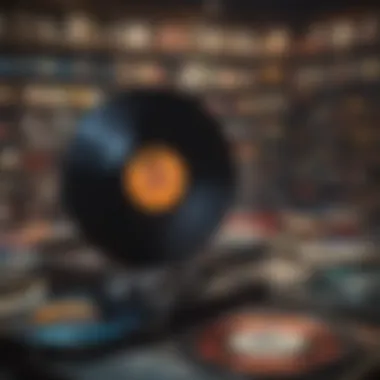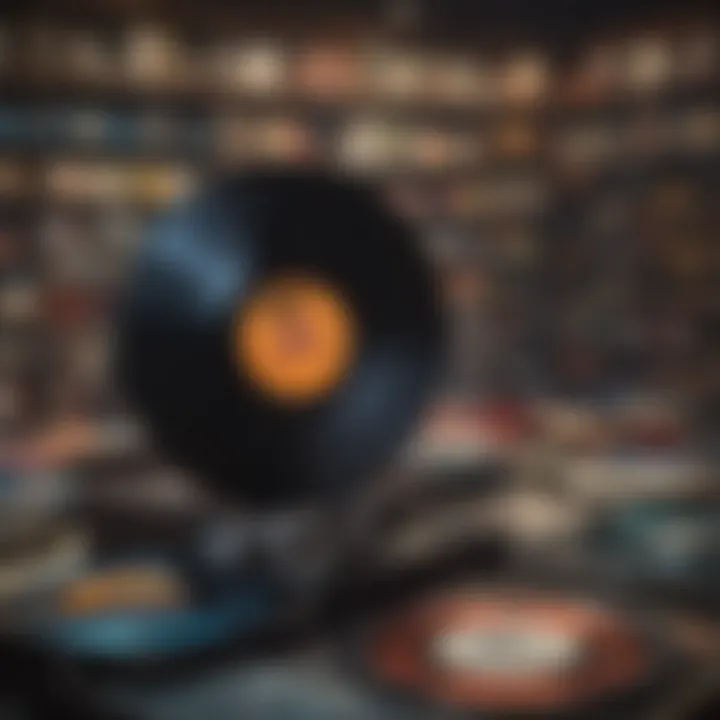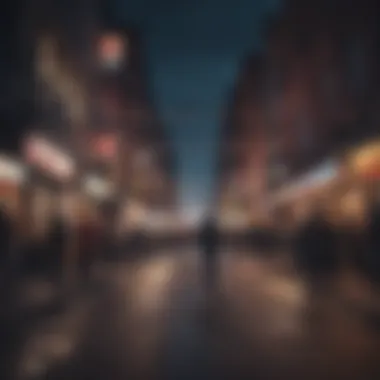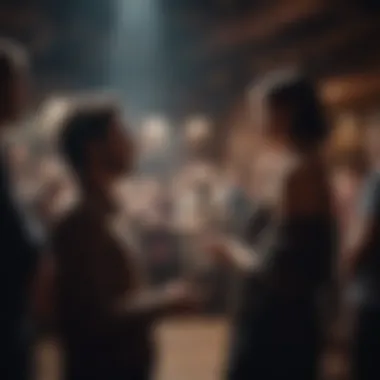Exploring the Fringe: Music's Hidden Realms


Intro
Fringe music represents a vibrant tapestry woven from the threads of subculture and experimentation, capturing sounds and ideas that often slip beneath the radar of mainstream exposure. Within this realm, a plethora of niche genres sprout, giving voice to unconventional artists and sparking grassroots movements that challenge conventional boundaries. This exploration takes us deep into the heart of music's uncommon realms, where every corner reveals fresh perspectives and unspoiled creativity.
As listeners, we owe it to ourselves to step outside our comfort zones and embrace the richness that fringe music offers. Whether it be the avant-garde soundscapes of experimental jazz or the raw energy of underground punk, these forms of expression contribute significantly to the larger music ecosystem. In looking closely at what drives this innovation, we uncover how the fringes shape not only artists but also the culture surrounding them.
Throughout this journey, we will delve into specific artists, dissect their influences, and analyze their contributions to the ever-evolving narrative of music. From the gritty streets of a bustling city to the serene isolation of an artist’s studio, the stories shared here will connect the dots between individual creativity and collective cultural movements, forming a compelling narrative that showcases just how fascinating the fringe of music can be.
Defining the Fringe in Music
When artists and audiences congregate in the vast world of sound, one finds oneself amidst various styles and genres. But what truly defines the fringe in music? To put it simply, fringe music represents those sounds that lie at the peripheries of the mainstream. It stands as a testament to creativity, marked by innovation, experimentation, and a bold rejection of the confines that often govern popular genres. This section seeks to peel back the layers, revealing why understanding the fringe is vital for anyone immersed in the music scene, be it artists, students, or aficionados.
One of the key aspects of fringe music is its role as a breeding ground for new ideas. Fringe genres often serve as the incubators of cultural evolution, giving rise to styles that can later be absorbed into popular music. Think back to how punk rock inspired countless movements or the echoes of garage rock resonating in contemporary indie circles. This historical reverberation illustrates the importance of recognizing fringe elements and their contributions to the wider music landscape.
Historical Context
To grasp the significance of fringe music, one must turn the clock back to pivotal moments in musical history. Consider the avant-garde movements of the early 20th century, where composers like John Cage and his experimentation with chance music challenged listeners’ perceptions. Such innovative spirits laid the groundwork for what would later bloom into genres like electronic music and modern jazz. In every decade since, numerous artists have pushed against the grain, whether it was the folk revival of the 1960s, which intertwined social activism with music, or the grunge explosion that rocked the early '90s.
The backdrop of opposition and innovation defines the essence of fringe music. As societal norms shift, so too do musical expressions, reflecting the complexities of the times. This historical perspective reminds us to view fringe music not merely as an offshoot but as an essential player in the larger narrative of cultural expression.
Contemporary Perspectives
Looking toward the present, the status of fringe music has transformed drastically with the advent of digital technology. Platforms like YouTube, Bandcamp, and SoundCloud empower artists to share their creations without the intermediation of traditional record labels. Musicians from the underground can now find themselves reaching listeners across the globe, paving new paths for their sounds. The democratization of music distribution allows for a myriad of voices to emerge, creating a mosaic that defies simple categorization.
In today’s landscape, we observe the merging of genres as a primary characteristic of the fringe. Artists are no longer confined to a single label; rather, they borrow from eclectic influences. This trend raises questions about purity and authenticity—what does it mean to be part of a genre when boundaries have become so fluid? The contemporary music enthusiast must navigate this rapidly evolving world, where the line between mainstream and fringe is often a mere flicker.
"Fringe music reflects society's diverse tapestry, giving voice to those often left unheard. It’s in these uncharted waters where true creativity thrives."
Each generation inherits the legacy of those who dared to dream outside the conventional. The exploration of fringe music is not just a retrospective lens, but a glimpse into the future of sound, one where adaptability and collaboration obsessively retain their vibrant pulse. To understand the fringe is to appreciate the totality of music’s evolution and the stories that shape its ongoing narrative.
The Significance of Niche Genres
Niche genres in music stand as silent rebels, often overlooked yet exceptionally rich in cultural value and artistic merit. They serve as vital cogs in the music machine, contributing unique sounds and perspectives that somewhat challenge the mainstream narrative. By delving into these lesser-known areas, we uncover not only unconventional forms of expression but also vital connections among communities of passionate listeners and creators. In a world where pop reigns supreme, niche genres act as a reminder of the endless creativity that exists just beyond the top charts.
At their core, niche genres are significant for their ability to foster dedicated subcultures. These cultivated communities are often united by shared interests and collective experiences that transcend geographical boundaries. The fans of such genres are not merely consumers of the music; they are active participants, often engaging deeply with the artists and the messages behind the music. In this way, niche genres can provide a sense of belonging that many seek out in an increasingly fragmented world.
Defining Niche Genres
When we talk about niche genres, we refer to music styles that cater to particular interests or themes and appeal to specific audiences, typically in smaller circles than mainstream music. These genres, such as shoegaze, vaporwave, or folk-punk, often thrive on idiosyncratic experiences and eccentric sounds. They usually don’t follow the broader commercial trends, allowing artists to explore avenues that are more personal or experimental.
Niche genres can also be characterized by their experimental nature. For example, math rock, which is known for complex time signatures and unconventional song structures, has carved a small yet devoted fanbase. So while the mainstream often churns out more universally palatable hits, these genres provide a sandbox for artists to push boundaries and explore new sonic territories. It’s a multifaceted exploration of art and emotion that invites listeners to engage on deeper levels.
Examples of Influential Niche Genres
Throughout music history, several niche genres have risen to prominence for their innovative spirit and cultural significance. Here are just a few notable examples:
- Post-Rock: Originating in the late 1980s, bands like Sigur Rós and Explosions in the Sky redefined rock by emphasizing instrumental explorations and atmospheric soundscapes. Their music often feels cinematic, steering clear of traditional verse-chorus structures.
- Wonky: A blend of hip-hop and electronic music, this genre is typified by its off-kilter beats and quirky sounds, often involving artists like Flying Lotus and Rustie. It showcases a fun take on rhythm and melody, appealing to those with an ear for the avant-garde.
- Chiptune: This genre harnesses the sounds of vintage video game consoles, creating a nostalgic yet fresh aesthetic. Artists like Anamanaguchi have brought these sounds into the limelight, melding them with contemporary music while engaging gamer's hearts.
- Dark Ambient: This genre captures the eerier aspects of sound, often associated with soundscapes that evoke feelings of dread or contemplation. Artists like Lustmord create elaborate works that can be immersive experiences, challenging the listener to confront their emotions.
Fringe genres thrive on their unique identities, often challenging societal norms and expressing underrepresented voices. This is not to say they seek mainstream acceptance; rather, they revel in their distinctiveness and cultivate communities that appreciate their authenticity. Ultimately, it is this combination of individuality and community that lends niche genres their critical significance in the ever-evolving world of music.
Unconventional Artists and Their Impact
The realm of fringe music is often painted with vibrant strokes of creative expression that defy mainstream boundaries. Unconventional artists embody this definition; they stretch the limits of traditional sounds and push the envelope, allowing listeners to explore the nooks and crannies of their musical sensibilities. By breaking rules and norms, these artists often open pathways to uncharted territories in the music landscape, igniting both innovation and inspiration along the way.
These artists play a vital role in shaping the music world. They challenge the status quo and serve as catalysts for change, inspiring others in the industry. By committing to their unique visions, they contribute to a diverse musical ecosystem that thrives on experimentation and collaboration, bringing attention to genres that may otherwise linger in the shadows.
Moreover, unconventional musicians often find themselves acting as social commentators. Their music reflects a range of perspectives, addressing issues that resonate deeply with their audiences, such as identity, politics, and community struggles. This actualization of thought through art can lead to collective movements and shifts, impacting culture far beyond the confines of musical performance.


"In a world increasingly filled with conformity, the risk taken by unconventional artists not only amplifies their voices but also gives a platform to the unheard."
Case Studies of Fringe Artists
When delving into the landscape of unconventional music, a few artists stand out, illustrating just how transformative the fringe can be. Take, for example, Björk. Known for her eclectic sound and avant-garde visuals, she has carved a niche by fusing elements of electronic music with classical and pop. Björk’s influence can be seen in the way she elevates storytelling within her music, often transporting listeners to surreal landscapes.
Another notable example is Frank Zappa, an artist who blended rock, jazz, classical, and avant-garde music to produce works that were as provocative as they were surprising. Zappa pushed his themes to the forefront, making listeners rethink their perceptions of music and art. His legacy encourages aspiring musicians to break free from conventional structures.
Additionally, consider the modern artist FKA twigs. Emerging from the recent experimental landscape, she integrates elements of R&B with unorthodox visuals and soundscapes, pushing boundaries on every level. Her audacious exploration of identity and femininity resonates deeply with her audience, creating a strong emotional connection that often elevates personal experiences in her songs, leading to broader conversations around these themes.
Cultural and Social Influences
Unconventional music has a knack for transcending mere entertainment. It often reflects and responds to cultural and social dynamics, interweaving with individual stories and broader societal issues. This relationship is especially significant in moments of social change. Artists like Rage Against the Machine used their platform to address political inequalities, inspiring a wave of activism amid the youth of the '90s. Their blend of rock and rap gave voice to the frustrations encapsulated within the marginalized populations.
The cultural significance of fringe music can extend into fashion, visual arts, and movements that define seasons of change. Take the punk rock movement, for example. It wasn’t just about the music; it was a declaration of rebellion against societal norms and political establishments. The style, ethos, and spirited defiance communicate an overall message that resonated with countless individuals seeking solidarity and expression in a tumultuous world.
Engagement also emerges through community-building efforts among fringe artists and their fans. Events like local festivals, underground shows, or online streaming concerts provide a breeding ground for collaboration. Here, the lines blur between artist and audience, fostering a collective experience that celebrates creativity and self-expression.
Through the lens of fringe music, listeners encounter a world where the unconventional is embraced and celebrated, echoing the diversity of human experience.
The Role of Alternative Music Scenes
Alternative music scenes play a pivotal role in shaping the landscape of fringe music. They act as incubation spaces for new sounds and styles, challenging the traditional notions of what music can be. These scenes are not just collections of bands or artists; they represent a cultural phenomenon where individuals gather around shared interests and values. The vibrancy of these communities is essential as they foster creativity, collaboration, and the exploration of artistic expression that often doesn’t fit the mainstream mold.
Mapping Alternative Scenes
When we think about alternative music scenes, it’s vital to map them out geographically and culturally. Take, for instance, the underground punk scene in cities like Washington D.C. during the late 1970s. It was not just a genre; it was an entire movement that embedded itself deeply into the local culture. Fast forward to today, where cities like Berlin, London, and New York serve as epicenters for various subgenres, ranging from electronic music to lo-fi indie rock.
Identifying these scenes includes examining the unique venues that give rise to them. Small bars, DIY spaces, and community centers often serve as birthplaces for alternative music. In these venues, artists can experiment without the pressure of commercial success, allowing for genuine, unfiltered creative expression.
Some key aspects include:
- Diverse Influences: Each scene is influenced by local culture and other musical styles, leading to distinctive sounds.
- Hybrid Genres: Alternative scenes often foster the emergence of fusion genres, mixing elements of different musical traditions to create new auditory experiences.
- Accessibility: Many of these scenes prioritize accessibility, inviting audiences of all backgrounds to engage without the fear of elitism.
Community and Collaboration
The essence of alternative music scenes lies in community and collaboration. Unlike mainstream music, which can sometimes feel isolated or competitive, alternative scenes often thrive on a spirit of togetherness. Members of these communities support one another, sharing resources, skills, and knowledge. There’s an inherent understanding that the success of one can contribute to the overall health of the scene.
For instance, in the indie folk scene, artists frequently perform together, blending their styles and exposing their audiences to a tapestry of sounds. This collaborative spirit can be witnessed in numerous music festivals that emphasize local talent, emphasizing camaraderie over competition.
Some notable points about this community-oriented approach include:
- Collective Identity: Many artists become synonymous with their scenes, creating an identifiable sound that audiences can connect to.
- Shared Values and Goals: These artists often promote messages that resonate with the community, diving into themes of social justice, environmental issues, and personal expression.
- Resource Sharing: It’s common for artists to exchange recording knowledge, share studios, or even collaborate on projects, enhancing the creative output.
"Alternative music scenes are like a patchwork quilt, each piece telling a unique story but together they create a larger narrative of cultural and artistic significance."
The exploration of alternative music scenes encourages not just an appreciation of unusual sounds but also an understanding of the rich social fabric that underpins them. As artists continue to push boundaries and audiences seek fresh experiences, the relevance of these communities only deepens in the musical realm.
Fringe Music and Mainstream Culture
Understanding the dynamics between fringe music and mainstream culture is crucial in dissecting how unconventional sounds and artists shape broader musical trends. This section will explore how elements from the fringes of the music landscape not only affect the mainstream but also facilitate a richer, more diverse environment for musical expression. It’s a dance between innovation and acceptance, where fringe music often serves as the incubator for ideas that might eventually seep into the mainstream.
Blurring the Lines: Fusion Genres
Fusion genres represent an interesting overlap between fringe and mainstream music. They arise when artists combine elements from various styles, creating a hybrid sound that can challenge traditional genre barriers. This blending often reflects cultural exchanges and personal experimentation, leading to new artistic expressions.
For example, imagine artists like Thundercat, whose work bridges funk, jazz, and electronic elements. His sound encapsulates a carefree attitude while also drawing from deep musical roots. It presents a unique case of how fringe elements can gain traction in the mainstream while keeping their innovative spirit alive.
Additionally, the popularity of fusion genres can demonstrate changing consumer preferences. When listeners become more accepting of diverse sounds, it signals a shift toward inclusivity in music. As a result, we can witness how genres like reggaeton or trap music—often tied closely to urban and local cultures—gain broader acceptance, further intertwining the lines between mainstream and fringe.


Key Points on Fusion Genres:
- Innovation: Fusion genres embody creativity, often leading to new sounds that captivate audiences.
- Cultural Cross-Pollination: The merging of different styles promotes cultural understanding and appreciation.
- Acceptance: As fusion genres gain popularity, they challenge traditional constraints, encouraging the mainstream to embrace a wider musical palette.
Mainstream Acceptance of Fringe Elements
The acceptance of fringe elements in mainstream music is not merely a trend but rather a reflection of evolving societal tastes. Listeners are increasingly seeking authenticity and depth in music, and artists who represent fringe genres often deliver that. This acceptance can be attributed to several factors:
- Digital Age Influence: With platforms like Spotify and Soundcloud, listeners have unprecedented access to a variety of sounds, allowing niche genres to rise.
- Cultural Shifts: As society becomes more diverse, so does its music. What was once considered fringe can find common ground in mainstream culture.
- Artists as Innovators: Many successful mainstream artists, such as Billie Eilish or Björk, actively incorporate elements from fringe genres into their work, blending commercial viability with artistic experimentation.
"Music is a universal language, but fringe music often speaks with a dialect that enriches the whole conversation."
The mutual interplay of fringe and mainstream highlights a symbiotic relationship where both sides benefit. Fringe artists get exposure, while mainstream culture gains new life through innovative ideas. As trends evolve, we can anticipate that the tides will continue to turn, and what is currently fringe today could very well dominate the mainstream tomorrow.
Grassroots Movements and Their Evolution
Grassroots movements in music signify more than just the creation of sound; they mark a profound connection between community, culture, and artistic expression. Their evolution has carved a unique niche within the vast landscape of music, highlighting how collective efforts can challenge mainstream narratives and offer alternative spaces for artistic exploration.
Origins of Grassroots Movements
The roots of grassroots movements in music can often be traced back to societal changes, political shifts, and cultural unrest. Historically, music has always served as a tool for protest and solidarity, with early examples flourishing in the civil rights movement and anti-war protests. One might think of the iconic Woodstock Festival of 1969, where music brought together a diverse crowd seeking peace and love amid turbulent times.
In the 1970s and 80s, movements like punk rock emerged from dissatisfaction with the mainstream music industry, reflecting an unwillingness to conform to commercial standards. This underground scene blossomed through DIY ethics, leading to independent record labels and cooperative venues that encouraged artist autonomy and creativity. The Ramones and Sex Pistols didn’t rise to fame through traditional means; rather, they found their voices in communities that valued their raw, unfiltered sound, inspiring countless artists to forge their paths.
Modern Grassroots Trends
Fast forward to the digital age, where technology and social media have fundamentally reshaped grassroots movements. Now, musicians can connect directly with their audiences, sidestepping traditional channels. Platforms like Bandcamp and Soundcloud allow indie artists to share their music widely, fostering new communities bound by shared taste rather than commercial viability.
Additionally, social media has served as a megaphone for diverse voices that may have once been ignored. Hashtags like #DIYMusicians and #IndieArtists frequently trend, building networks that support and promote marginalized genres. New collective phenomena are popping up, such as the Bedroom Pop genre, where artists like Clairo and Rex Orange County craft heartfelt tracks in the comfort of their bedrooms, showcasing the intimate power of modern creation.
The beauty of these movements lies in their ever-evolving nature. As cultural landscapes shift, grassroots movements adapt, embracing new technologies and social discourses while still echoing the rebellious spirit of their forebears.
"Grassroots movements urge all of us to remember: change begins at the community level, and art is often the voice of that change."
The Future of Fringe Music
The landscape of fringe music is evolving faster than a hummingbird’s wings. With new advancements constantly emerging, the future of fringe music promises a tapestry woven from threads of innovation, interaction, and integration. This section highlights crucial elements that will shape the fate of fringe music in the coming years. Understanding these future dynamics isn’t just for door-knockers trying to find fresh sounds; it’s important for musicians, producers, and fans who wish to stay one step ahead.
Technological Influences
As the sun rises on new technologies, they cast fascinating shadows on the pathways of fringe music. Digital tools allow artists to create incredibly diverse sounds, breaking down traditional barriers that once seemed insurmountable. Consider audio production software like Ableton Live or FL Studio—these platforms empower anyone from bedroom creators to seasoned pros, giving them the ability to craft intricate soundscapes with just a few clicks.
Social media has also reshaped how music finds its audience. Where once traditional labels held the keys to success, platforms like SoundCloud and Bandcamp allow independent musicians to maintain control over their work. Artists can release niche music directly into the ears of eager listeners, dodging the often convoluted machinery of the mainstream.
Moreover, artificial intelligence tools are emerging, which help in music creation and even curating playlists tailored to individual tastes. The algorithm-driven approach to recommendation might lead to discovering hidden gems in the realm of fringe music. As these technologies march forward, we'll witness a hybridization of styles, often resulting in genres that are as eclectic as the creators behind them.
"The digital age has democratized music production, giving rise to a new era of creativity where anyone can become a producer."
Globalization and Cultural Exchange
Globalization, while often perceived as a double-edged sword, has undeniably enriched the world of fringe music. The internet bridges vast cultural chasms, allowing artists to draw inspiration from across the globe. A folk tune from Mali mixed with elements of electronic pop may suddenly resonate in Berlin, as artists collaborate regardless of geographic barriers. This cultural exchange breathes life into fringe music, resulting in projects that reflect a broader array of sounds and stories.
New York City’s vibrant underground scene, coupled with influences from Japan’s avant-garde movements, creates a rich audio tapestry that epitomizes this cross-cultural dialogue. As artists partake in dialogues that span continents, we can anticipate an exciting array of musical fusions
The emergence of global music festivals also underscores this phenomenon. Events like Glastonbury in the UK and Coachella in the USA not only feature local artists but curate line-ups that showcase diverse talents from around the world. This kind of exposure can turn a humble indie band from a remote town into an overnight sensation, merely due to the discovery potential inherent in diverse audiences.
Exploring Listener Dynamics


Understanding the dynamics of listeners in fringe music is pivotal for unraveling the rich tapestry that makes up this unique soundscape. The exploration of listener dynamics provides insights into how different audience segments engage with music that defies conventional categorization. By examining these interactions, we can appreciate the diverse motivations behind why certain groups gravitate towards niche sounds and how these connections influence both the artists and the broader music community.
The Psychology of Niche Audiences
Niche audiences often harbor a specific kind of passion that goes beyond casual listening. They are usually driven by a desire for authenticity, personal connection, and a sense of belonging. When we step into the shoes of these listeners, it becomes evident that music serves as a canvas for expressing individuality and challenging societal norms. These audiences are not just passive consumers; they're active participants in the music's evolution.
Research into how listeners perceive fringe music reveals that many value the storytelling aspect of songs, particularly in genres like folk punk or experimental jazz, where the emotional narrative often resonates with personal experiences. This bond creates a loyalty that is hard to break; it’s not just about tunes but shared values and ideals.
- Seeking Authenticity: Many view fringe music as a rebellion against mainstream trends, making them feel special for supporting what they see as true art.
- Community Building: The niche audience often seeks community around particular genres, fostering connections with like-minded individuals through concerts, social media platforms, and local scenes.
The engagement within these circles amplifies the music itself, making niche genres feel alive and significant.
"The fringe music experience is less about fitting in and more about standing out, sharpening one's identity in a crowd of sameness.”
Curation and Discovery in Digital Spaces
In today’s fast-paced digital world, the way listeners discover and curate their musical tastes has evolved dramatically. Access to an endless array of content presents both challenges and opportunities. Platforms like Spotify, Bandcamp, and SoundCloud are vital in shaping listener behavior as they provide tools for deep dives into lesser-known genres. Curation is fundamental, as listeners become their own DJs, hand-picking playlists that speak to their individual preferences—even at the fringes.
- Algorithmic Influence: Users often rely on algorithms to introduce them to new music. While this can lead to exciting discoveries, it also raises questions about the authenticity of what is recommended. Are we truly exploring the fringes, or are we merely following curated pathways laid out by automated systems?
- Social Media and Sharing: Platforms like Reddit or Facebook have given rise to communities that focus on niche genres, further promoting the underground music scene. Discussions, recommendations, and shared playlists proliferate, allowing for grassroots movements to thrive buoyed by user-driven content.
As listeners curate their unique soundtracks, they don't just consume music; they engage in a transformative experience, shaping the dynamics between artists and audiences. This changing landscape highlights the importance of understanding the motivations that drive listeners to their chosen sounds, especially at the fringes.
Cultural Significance of Fringe Music
Fringe music occupies a unique and vital space within the broader context of cultural expression. It resonates on multiple levels, engaging with social, political, and existential themes that are often overlooked by mainstream artists. Many of these genres serve as a platform for voices that challenge the status quo, providing commentary on a variety of societal issues. For listeners, the significance lies not only in the soundscapes they explore but also in the narratives they evoke and the identities they foster.
Political and Social Commentary
One of the striking features of fringe music is its ability to voice dissent and critique societal norms. Unlike mainstream music, which often aims for mass appeal, fringe artists frequently dive into complex political issues, using their craft to provoke thought and discussion. For example, the punk movement of the late 20th century served as a backdrop for anti-establishment sentiments, with bands like The Sex Pistols and Crass delivering blunt messages about social injustice.
By addressing topics such as inequality, war, and corruption, fringe music invites listeners to reflect on their surroundings and question prevailing ideologies. The remarks made through these songs can function as catalysts for social movements, inspiring action in ways that resonate even outside of musical boundaries.
"Music is the weapon of the future."
- Fela Kuti
Whether it’s through the raw energy of rap and hip-hop, the avant-garde expressions of noise music, or the haunting melodies of folk protest songs, the impact is often profound. By bringing attention to the struggles of marginalized groups or highlighting systemic failures, fringe music not only amplifies these voices but also plays an essential role in shaping public opinion. Understanding this relationship is crucial for grasping how music can serve as a form of activism.
Representation and Identity
Fringe music also has a significant role in shaping personal and collective identities. Many artists use their work to explore their cultural backgrounds, sexual orientations, and life experiences, giving rise to a diverse range of representations. This aspect is particularly crucial for marginalized communities, as it creates a space where their experiences are validated through art. Numerous genres, from Afrobeat to Queer Pop, actively disrupt stereotypes and encourage representation that mainstream culture might ignore.
In this realm, representation does not merely pertain to visibility; it extends to the creation of narratives that empower individuals and groups. Artists like Janelle Monáe and Rina Sawayama challenge prevailing notions of identity while celebrating their intersectional influences. Their work serves as a reminder that music can be a powerful agent of self-expression and affirmation.
Furthermore, the diversity found in fringe music fosters a sense of belonging among listeners who might feel alienated by conventional genres. The connection between the artist's experiences and the audience often transcends mere entertainment, forging communities based on shared feelings and struggles.
In sum, the cultural significance of fringe music extends far beyond entertainment. It acts as a vehicle for political activism, a platform for representation, and a means to explore complex identities. As we continue to explore these uncommon realms of music, it becomes increasingly clear that the fringes hold stories and connections that require our attention.
Concluding Thoughts
As we gaze upon the vibrant tapestry of fringe music, it becomes clear that this segment of the musical landscape is not merely a niche but a thriving ecosystem teeming with creativity and innovation. The exploration of fringe music has illuminated its critical role in shaping cultural dialogues, providing a counter-narrative to mainstream sounds. This makes concluding thoughts on the matter not just a summary, but a reflection on its broader implications.
Reflection on the Impact of Fringe Music
Fringe music serves as a crucible for experimentation and ideation. Artists unshackled from commercial constraints often address themes that resonate deeply within society. Their work touches on pressing social issues, personal identity, and artistic freedom. For example, consider the influence of noise music, which unsettles traditional aesthetics and pushes listeners to confront discomfort. This deliberately anti-mainstream approach captures the raw essence of human expression and creates a dialogue that reverberates far beyond the music industry.
Moreover, fringe genres possess a unique ability to give voice to those often marginalized by mainstream culture. Whether it’s through the lens of LGBTQ+ performance art or the intersection of hip-hop and activism, fringe artists parlay their experiences into their art, galvanizing communities along the way. When one encounters music from these corners of the world, it becomes evident that it transcends entertainment; it becomes an agent for societal change.
Future Directions of Exploration
The trajectory for fringe music doesn't seem to be slowing down anytime soon. With the ever-evolving technological landscape and increased global interconnectedness, new opportunities for exploration will continue to arise. Digital platforms empower grassroots movements, allowing indie artists to reach global audiences without the heavy hand of record labels stifling their creativity.
Also, as music lovers turn toward diverse and authentic sounds, the intersectionality within fringe genres will likely grow. We may see subgenres blend in novel ways, giving rise to hybrid styles that challenge existing categories. For instance, the fusion of traditional folk with electronic elements can result in a sound that honors heritage while embracing modernity.
The evolution of fringe music is a testament to humanity's unyielding quest for expression, often reflecting the zeitgeist of various communities around the world.
In closing, as we reflect on the vibrant pathways of fringe music, it becomes clear that its importance cannot be underestimated. It continuously invites listeners to push boundaries, question norms, and celebrate the rich diversity of human experience. The journey of exploring these uncommon realms promises not just to reveal hidden musical treasures, but also to uncover the profound societal narratives they encapsulate.







